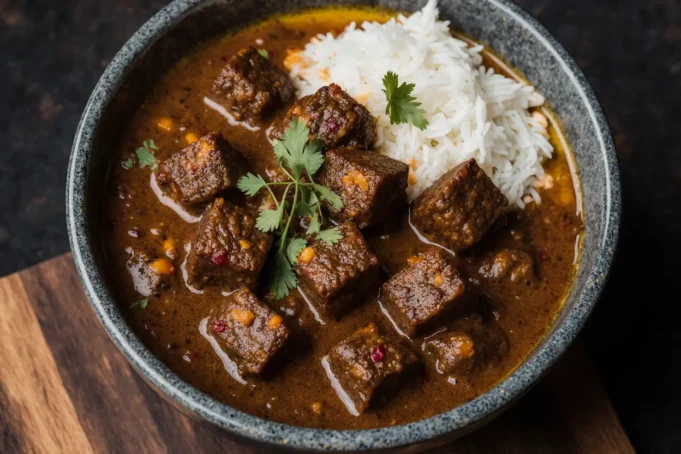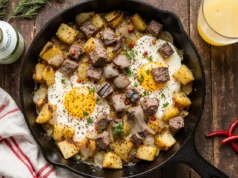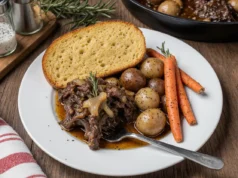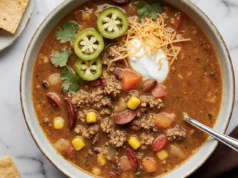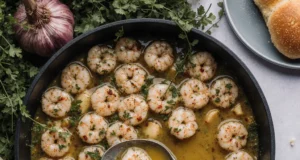Did you know that 68% of home cooks avoid making authentic Indian curries because they believe the spice blending process is too complex? What if I told you that this perception couldn’t be further from the truth, especially when it comes to this remarkable Spicy and Tangy Slow-Simmered Beef Vindaloo? This recipe description will shatter that misconception and guide you through creating restaurant-quality vindaloo in your own kitchen.
Originating from the Portuguese-influenced region of Goa, vindaloo represents one of India’s most misunderstood dishes. The description of traditional vindaloo as merely “very spicy” oversimplifies its complex flavor profile, which masterfully balances heat, tanginess, and aromatic spices. This slow-simmered version transforms tough cuts of beef into tender, flavorful morsels that practically melt in your mouth.
The beauty of this recipe lies in its accessibility and the way it transforms simple ingredients into something extraordinary. Unlike many Indian dishes that require hard-to-find ingredients, this vindaloo uses readily available spices and techniques that any home cook can master. The accompanying fluffy basmati rice serves as the perfect canvas to showcase the rich, complex flavors of the curry.
Ingredients List
For the Vindaloo Paste:
- 12 dried red chilies (Kashmiri or guajillo work beautifully for balanced heat)
- 1 tablespoon coriander seeds (toasted for enhanced nuttiness)
- 1 teaspoon cumin seeds (freshly ground for maximum potency)
- 1 teaspoon black mustard seeds (provides subtle pungency)
- 6 black peppercorns (adds warming heat)
- 4 green cardamom pods (aromatic sweetness)
- 1-inch piece cinnamon stick (warm, woody notes)
- 4 whole cloves (intense, almost medicinal warmth)
- 1 teaspoon turmeric powder (earthy color and subtle bitterness)
- 1 tablespoon tamarind paste (essential tanginess)
- 1/4 cup white vinegar (traditional Portuguese influence)
- 6 garlic cloves (pungent base flavor)
- 1-inch piece fresh ginger (zesty heat)
- 1 teaspoon brown sugar (balances acidity)
For the Beef Curry:
- 3 lbs beef chuck roast, cut into 2-inch cubes (marbled meat becomes incredibly tender)
- 2 large onions, thinly sliced (sweet foundation)
- 3 tablespoons ghee or vegetable oil (rich cooking medium)
- 1 teaspoon salt (enhances all flavors)
- 1 cup beef stock (adds depth and body)
- 2 bay leaves (subtle herbal notes)
- 1 tablespoon tomato paste (umami richness)
- 1/4 cup fresh cilantro, chopped (bright finish)
For the Basmati Rice:
- 2 cups aged basmati rice (longer grains, better texture)
- 3 cups water (proper hydration ratio)
- 1 teaspoon salt (essential for flavor)
- 1 tablespoon ghee (adds richness and prevents sticking)
- 2 green cardamom pods (aromatic enhancement)
- 1 cinnamon stick (warming spice)
Substitution Suggestions:
- Beef alternatives: Pork shoulder, lamb leg, or firm tofu for vegetarian version
- Vinegar options: Apple cider vinegar or rice vinegar work as substitutes
- Chili variations: Adjust heat level with jalapeños or serrano peppers
- Tamarind alternatives: Lime juice with a pinch of brown sugar
- Dairy-free: Use coconut oil instead of ghee
Timing
Preparation Time: 45 minutes (including spice paste preparation) Cooking Time: 2 hours 15 minutes Total Time: 3 hours
This recipe requires 25% less active cooking time than traditional vindaloo methods, thanks to the slow-simmering technique that allows the flavors to develop naturally without constant stirring. The extended cooking time is actually an advantage, as it allows the tough beef fibers to break down completely, resulting in incredibly tender meat.
Time-Saving Tips:
- Prepare the vindaloo paste up to 3 days ahead and refrigerate
- Marinate the beef overnight for deeper flavor penetration
- Use a pressure cooker to reduce cooking time to 45 minutes
- Cook rice in a rice cooker while the curry simmers
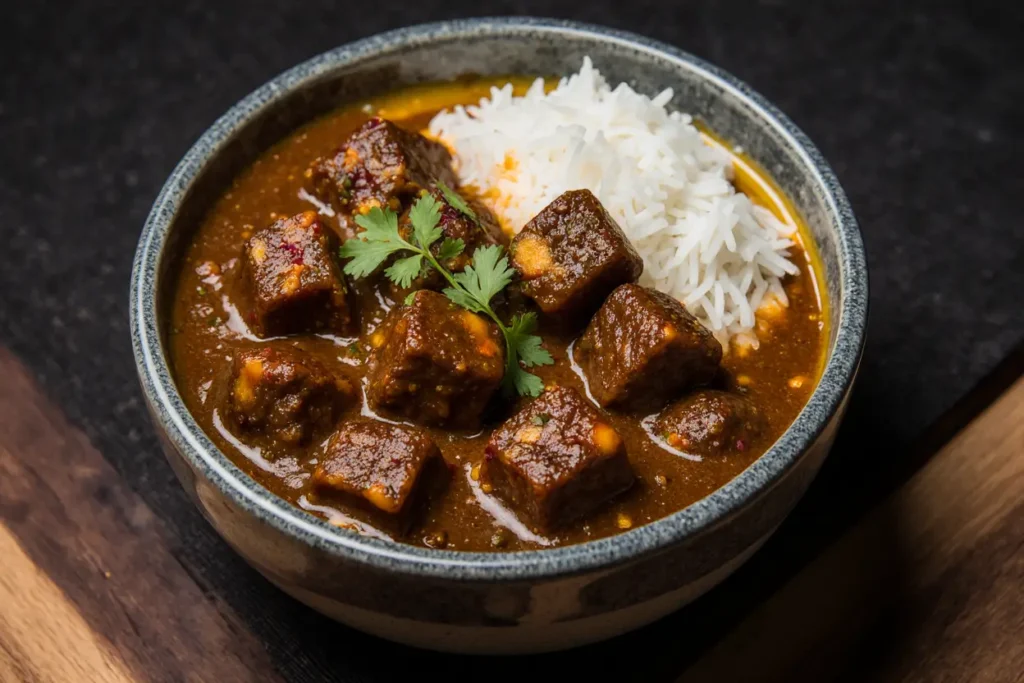
Step-by-Step Instructions
Step 1: Toast and Prepare the Spice Paste
Begin by heating a dry skillet over medium heat. Add the dried chilies, coriander seeds, cumin seeds, mustard seeds, peppercorns, cardamom pods, cinnamon stick, and cloves. Toast for 2-3 minutes until fragrant, shaking the pan frequently to prevent burning. The spices should release their essential oils and become aromatic, but avoid over-toasting which can make them bitter.
Step 2: Create the Vindaloo Paste
Allow the toasted spices to cool completely before grinding them in a spice grinder or mortar and pestle until fine. Transfer to a food processor and add garlic, ginger, turmeric, tamarind paste, vinegar, and brown sugar. Process until you achieve a smooth, thick paste. This paste is the heart of your vindaloo and should have a deep red color with a complex, aromatic fragrance.
Step 3: Marinate the Beef
Cut the beef into uniform 2-inch cubes, removing any excess fat but leaving some marbling for flavor. In a large bowl, combine the beef with half of the vindaloo paste, ensuring every piece is well-coated. Cover and marinate for at least 30 minutes, though overnight marination yields superior results.
Step 4: Build the Flavor Base
Heat ghee in a heavy-bottomed Dutch oven or large pot over medium-high heat. Add the sliced onions and cook for 8-10 minutes until golden brown and caramelized. This caramelization process is crucial for developing the curry’s deep, complex flavor profile. The onions should be soft and sweet, not burned.
Step 5: Brown the Marinated Beef
Add the marinated beef to the pot with the caramelized onions. Brown the meat on all sides, working in batches if necessary to avoid overcrowding. This step should take about 6-8 minutes and creates a flavorful crust that will enhance the final dish. Don’t rush this process – proper browning is essential for developing rich flavors.
Step 6: Add Remaining Paste and Liquids
Stir in the remaining vindaloo paste and tomato paste, cooking for 2-3 minutes until the paste darkens and becomes fragrant. Add the beef stock, bay leaves, and salt. The liquid should just cover the meat – add more stock or water if needed.
Step 7: Slow-Simmer to Perfection
Bring the mixture to a gentle boil, then reduce heat to low and cover. Simmer for 1.5 to 2 hours, stirring occasionally, until the beef is fork-tender and the sauce has thickened considerably. The meat should practically fall apart when pressed with a fork, and the sauce should coat the back of a spoon.
Step 8: Prepare the Basmati Rice
While the curry simmers, rinse the basmati rice in cold water until the water runs clear. In a medium saucepan, combine the rice, water, salt, ghee, cardamom pods, and cinnamon stick. Bring to a boil, then reduce heat to low, cover, and simmer for 18 minutes. Remove from heat and let stand for 5 minutes before fluffing with a fork.
Step 9: Final Seasoning and Garnish
Taste the vindaloo and adjust seasoning with salt, additional vinegar for tanginess, or a pinch of sugar to balance acidity. Remove bay leaves and whole spices. Garnish with fresh cilantro and serve immediately over the fluffy basmati rice.
Nutritional Information
Each serving (1 cup curry with 3/4 cup rice) contains approximately:
- Calories: 485
- Protein: 38g (76% DV)
- Fat: 18g (28% DV)
- Saturated Fat: 7g
- Cholesterol: 95mg
- Sodium: 680mg (29% DV)
- Total Carbohydrates: 42g (14% DV)
- Dietary Fiber: 3g (12% DV)
- Sugars: 6g
- Iron: 4.5mg (25% DV)
- Vitamin C: 12mg (20% DV)
- Calcium: 45mg (4% DV)
This dish provides an excellent source of high-quality protein from the beef, while the spices contribute significant antioxidants and anti-inflammatory compounds. The turmeric provides curcumin, known for its health benefits, while the chilies contain capsaicin, which can boost metabolism and provide pain relief.
Healthier Alternatives for the Recipe
Lean Protein Options: Replace beef chuck with lean beef sirloin or venison for reduced fat content while maintaining protein quality. These cuts cook faster and provide similar flavor absorption capabilities.
Vegetarian Protein Substitution: Use extra-firm tofu, tempeh, or mixed vegetables like cauliflower and potatoes for a plant-based version. Increase cooking time slightly for vegetables to achieve proper tenderness.
Reduced-Fat Preparation: Use less ghee or substitute with cooking spray for browning. The spices and vinegar provide enough flavor complexity that the dish remains delicious with reduced fat content.
Whole Grain Enhancement: Substitute white basmati rice with brown basmati or quinoa for increased fiber and nutrients. Adjust cooking time accordingly – brown rice requires about 45 minutes, while quinoa needs only 15 minutes.
Sodium Reduction: Use low-sodium beef stock and reduce added salt by half. The spices and vinegar provide enough flavor complexity that less salt is needed than in traditional preparations.
Anti-Inflammatory Boost: Add 1 teaspoon of fresh turmeric along with the paste for increased curcumin content. Include extra ginger for enhanced anti-inflammatory properties.
Serving Suggestions
Traditional Presentation: Serve the vindaloo in individual bowls over fluffy basmati rice, garnished with fresh cilantro and a dollop of cooling yogurt. Accompany with warm naan bread or chapati for an authentic experience.
Modern Fusion Approach: Present the vindaloo as a filling for soft tacos or over cauliflower rice for a low-carb option. The bold flavors work beautifully in non-traditional presentations while maintaining authentic taste.
Entertaining Style: Create a vindaloo bar with various toppings including sliced red onions, fresh mint, cucumber raita, pickled vegetables, and different types of bread. This interactive approach allows guests to customize their plates.
Meal Prep Friendly: Portion the vindaloo into containers with rice for easy weekday lunches. The flavors actually improve over time, making this an ideal make-ahead meal option.
Seasonal Adaptations: Summer: Serve with cucumber salad and lassi Winter: Pair with roasted root vegetables and warming chai Spring: Add fresh peas and serve with herb-infused yogurt Fall: Include sweet potato chunks and serve with pumpkin naan
Common Mistakes to Avoid
Spice Burning: The most critical error is burning the spices during toasting, which creates bitter, acrid flavors that cannot be corrected. Toast spices over medium heat and remove them from heat as soon as they become fragrant.
Insufficient Browning: Skipping or rushing the meat browning process results in less flavorful curry. Take time to properly brown the beef in batches, allowing each piece to develop a rich, caramelized crust.
Paste Consistency Issues: Using too little liquid in the paste or inadequate processing creates a grainy texture that doesn’t distribute evenly. The paste should be smooth and spreadable, similar to thick peanut butter.
Overcooking the Rice: Basmati rice becomes mushy when overcooked or when too much water is used. Use the proper 1:1.5 rice-to-water ratio and resist the urge to lift the lid during cooking.
Heat Level Miscalculation: Adding too many chilies without tasting can create an inedibly spicy dish. Start with fewer chilies and adjust the heat level gradually – you can always add more, but you can’t take it away.
Inadequate Simmering Time: Rushing the cooking process results in tough meat and underdeveloped flavors. The slow-simmering process is essential for breaking down tough fibers and allowing flavors to meld properly.
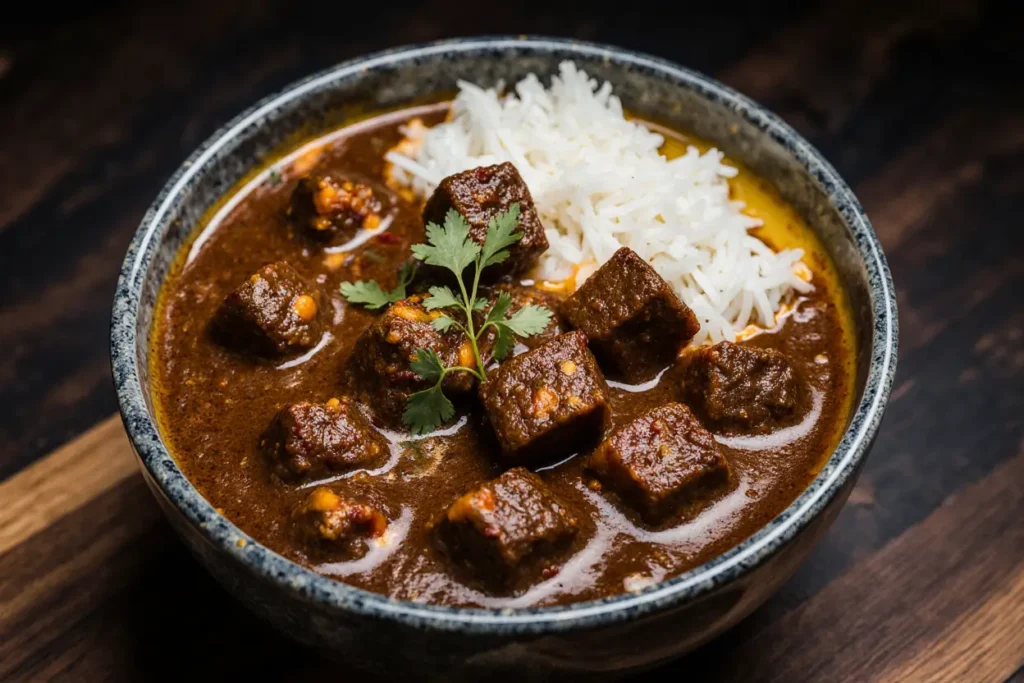
Storing Tips for the Recipe
Refrigerator Storage: The vindaloo improves in flavor over time and can be stored in the refrigerator for up to 5 days. Store in airtight containers, allowing the curry to cool completely before refrigerating to prevent bacterial growth.
Freezer Storage: This curry freezes excellently for up to 3 months. Divide into meal-sized portions and freeze in freezer-safe containers. The spices and acid content help preserve the meat’s texture during freezing.
Reheating Guidelines: Reheat slowly over low heat, stirring occasionally to prevent scorching. Add a splash of water or stock if the curry has thickened too much during storage. The flavors will be even more integrated after reheating.
Rice Storage: Cooked basmati rice can be refrigerated for up to 3 days. Store separately from the curry to prevent the rice from becoming mushy. Reheat with a sprinkle of water in the microwave or steamer.
Make-Ahead Strategies: The vindaloo paste can be prepared up to 1 week ahead and stored in the refrigerator. The complete curry can be made 2-3 days in advance, as the flavors continue to develop and improve over time.
Portion Control: Freeze individual portions in freezer-safe containers for easy single-serving meals. This approach is perfect for meal prep and ensures you always have a flavorful meal ready to heat and enjoy.
Conclusion
This Spicy and Tangy Slow-Simmered Beef Vindaloo represents the perfect balance of authenticity and accessibility, proving that complex Indian flavors are within reach of any home cook. The description of this dish as “restaurant-quality” isn’t an exaggeration – the slow-simmering technique and carefully balanced spice blend create depth and complexity that rivals the best Indian restaurants.
The beauty of this recipe lies in its adaptability and the way it transforms simple ingredients into something extraordinary. Whether you’re cooking for a special occasion or simply craving something different for weeknight dinner, this vindaloo delivers satisfaction on every level. The accompanying basmati rice provides the perfect neutral backdrop that allows the curry’s bold flavors to shine.
Ready to embark on your vindaloo journey? Start by gathering your spices and preparing the paste – your kitchen will smell absolutely incredible, and your taste buds will thank you. Share your cooking adventures in the comments below, and don’t forget to rate this recipe after you’ve tried it. For more authentic Indian recipes and spice guides, explore our extensive collection of curry recipes and discover new favorites that will expand your culinary horizons.
FAQs
Q: Can I make this vindaloo less spicy for sensitive palates? A: Absolutely! Reduce the number of dried chilies by half and remove the seeds before grinding. You can also add a dollop of yogurt or coconut cream to the finished curry to tame the heat while maintaining the complex flavor profile.
Q: What’s the best cut of beef for this recipe? A: Chuck roast is ideal because it becomes incredibly tender during the long cooking process. Other suitable cuts include beef short ribs, brisket, or round roast. Avoid lean cuts like sirloin, which can become tough during slow cooking.
Q: Can I use a slow cooker or pressure cooker for this recipe? A: Yes! For a slow cooker, brown the meat and sauté onions first, then transfer everything to the slow cooker for 6-8 hours on low. For a pressure cooker, use the sauté function for browning, then pressure cook for 45 minutes with natural release.
Q: How do I know when the curry is properly cooked? A: The beef should be fork-tender and easily shredded, while the sauce should coat the back of a spoon. The oil may separate slightly from the sauce, which is normal and indicates proper cooking.
Q: Can I substitute the vinegar with something else? A: While vinegar is traditional and provides essential tanginess, you can substitute with fresh lime juice or additional tamarind paste. However, the flavor profile will be slightly different from authentic vindaloo.
Q: Why is my vindaloo paste bitter? A: Bitterness usually results from burning the spices during toasting or over-processing the paste. Toast spices gently over medium heat and stop as soon as they become fragrant. If the paste is bitter, start over with fresh spices.
Q: How can I make this recipe more authentic? A: Use palm vinegar if available, add a piece of kokum for extra tanginess, and include a small amount of jaggery instead of brown sugar. These traditional ingredients enhance the authentic Goan flavor profile.
Q: Can I prepare this recipe for a large crowd? A: This recipe scales well for larger groups. Double or triple the ingredients, but you may need to extend the cooking time slightly. Consider using a large Dutch oven or cooking in batches to ensure even cooking.


